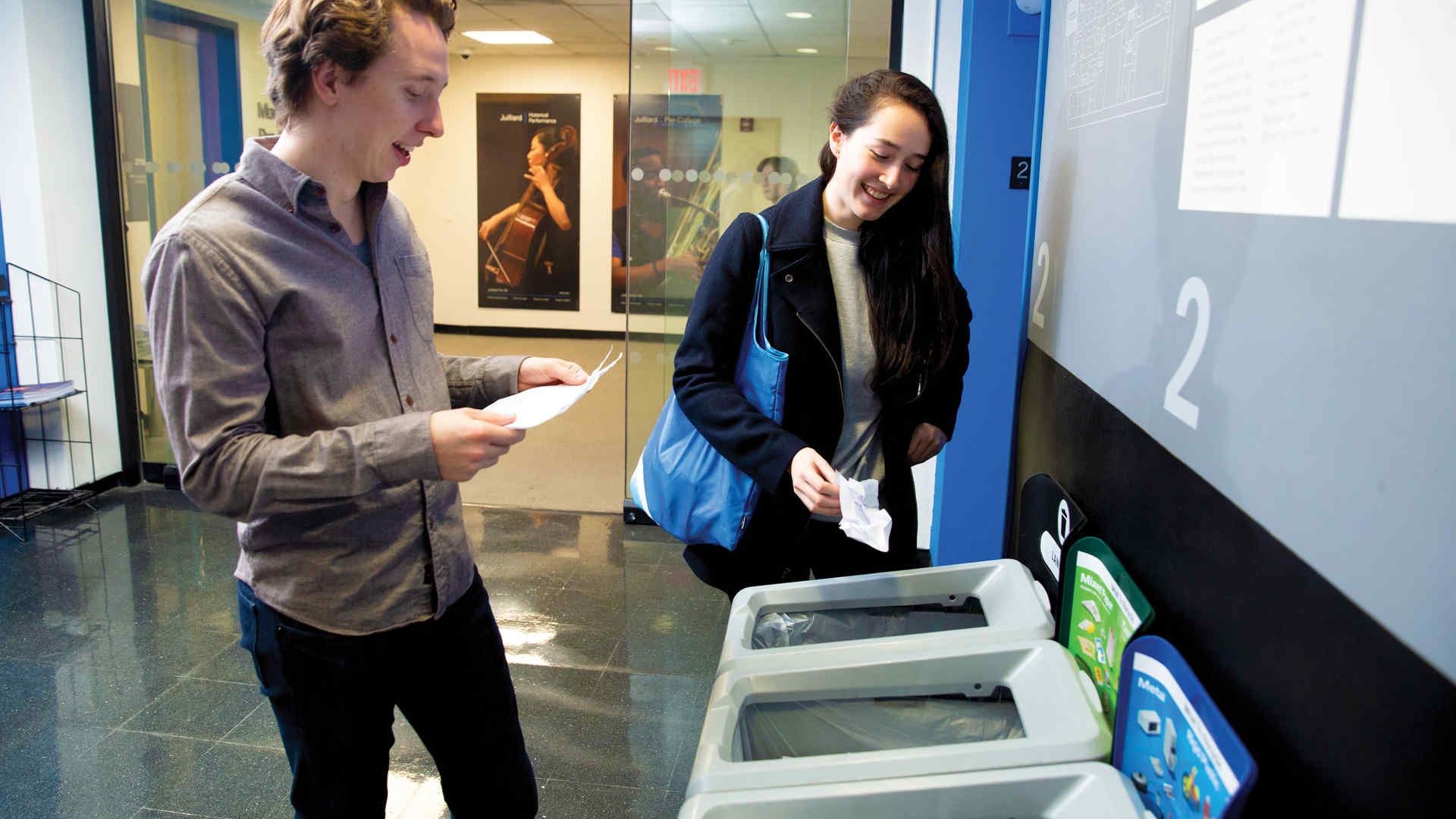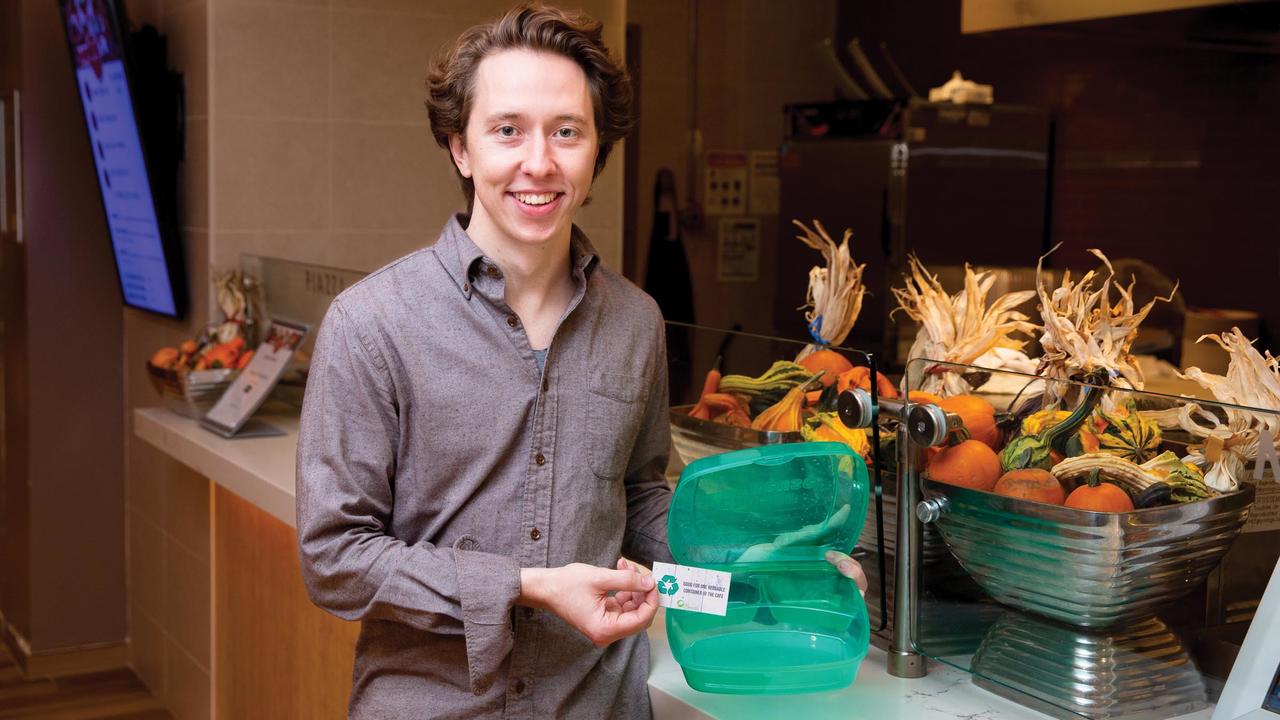
Making Art in an Uncertain Time for the Planet
Why learn what a Neapolitan chord is when “If you’re younger than 60, you have a good chance of witnessing the radical destabilization of life on earth—massive crop failures, apocalyptic fires, imploding economies, epic flooding, hundreds of millions of refugees fleeing regions made uninhabitable by extreme heat or permanent drought”?
And why should you bother with reusable containers, more efficient thermostats, and urban gardening when “If you’re under 30, you’re all but guaranteed to witness it”?
These are the questions being asked in fall 2019, as Professor Steven Laitz teaches two sections of Theory Pedagogy, the earth warms to 1.71°F above the 20th-century average(1), and Juilliard inaugurates its new Green Club.
New reusable containers are rolling out this fall at the Juilliard and SAB (School of American Ballet) Café. For a refundable deposit of $5 in cash or meal plan points, students can get a green “Choose, ’N’ Reuse” container. You can get one, you can leave it at the café after eating (you’ll be given a redeemable card), and it will be washed and ready for the next meal. Or you can take it with you and exchange it for a clean one at your next meal.
The program has the potential to eliminate hundreds of single-use containers at the caf daily. The Rose Building recycling is routed to a plant in New Jersey, making this initiative a practical and useful one. It solves small problems that are part of bigger problems, and makes people happy along the way: Those involved in the recycling chain have their load lessened, everyone on the front end feels good about doing something useful for the world, and the containers are nicer to hold in your hands than the disposable ones. These things are their own ends.
In Theory Pedagogy class, students are reviewing the dozens of texts used to teach musical fundamentals, ear training, and harmony. Professor Laitz says that the freshman question “Why do I have to take theory?” now has new motivations: not just “because I don't understand how it matters to my playing,” but also “because what use will music be when the world’s ending?”
Well, it seems music is always there when the world is ending, from the band on the Titanic to Messiaen’s Quartet for the End of Time, composed and performed in a Nazi prison camp. But there are also more practical answers to this question.

The art historian Kenneth Clark said that in order to build things, people need a “sense of permanence.” Without that, people “don't feel the need to look forward beyond the next season or the next voyage or the next battle. And for that reason it doesn’t occur to them to build stone houses, or to write books.”(2) Or to study Music Theory for that matter. And yet somewhere, on the edge of permanence, the first stone building is built. A vote for permanence, let’s say. Reusable containers and music theory are votes too. And such votes are important.
“We’ve got an opportunity to change things, because on the course we’re headed—well we've gotta change the course were headed in” says first-year cellist Ben Doane, one of the first members of the Green Club and its sustainability research coordinator. “Peaceful demonstrations involving more than 3.5 percent of the population bring about change twice as frequently as armed uprisings,” he adds, referring to research by Erica Chenoweth.(3)
Climate awareness is already at an all-time high, especially in places like Juilliard. The question now is whether to make an informed investment in our perilous future.
Forty students (roughly 3.5 percent of the Juilliard student population) have signed up for the Green Club already, and many of them participated in the Global Climate Strike at the end of September. But reaching that number of committed demonstrators outside the school remains a challenge. “To be totally honest, I think that maybe it takes the emergency really being felt.” says third-year violinist Sophia Steger, a founding member and the president of the club. “And that’s hard right now because the effects of climate change are being felt differently around the world, and a lot of things still feel pretty distant to New Yorkers.”(4)
And yet Juilliard stands as a testament to the power dance, drama, and music have to make things felt. “Performance is about communication,” Sophia says, “and I think that it's easy for us to make this message a strong part of what we do.” Last year students produced a short opera about climate change, and Sophia continues to encourage composers and performers to make it a part of their message.
“These student groups have such an immense ability to influence the direction of the organization,” says Cameron Christensen, Juilliard's associate vice president for facilities and the club’s advisor. “We're here for the students, and we’re here to educate artist citizens.” Artist citizens, in turn, have an immense ability to influence the direction of the world at large. The Renaissance was, after all, before revolutionizing modern politics, science, technology, and economics, an artistic movement.
And so, at Juilliard, students continue to learn the Neapolitan chord. We are using the reusable containers. We are writing music about it. Together we’re putting down stone walls, though the water is rising.
First-year composition master’s student Ben Sellick received his bachelor’s degree from the University of Manitoba and holds a Juilliard Scholarship
Notes
(1) NOAA National Centers for Environmental Information, State of the Climate: Global Climate Report for September 2019.
(2) Clark, Kenneth (1969). Civilisation: A Personal View. London: BBC and John Murray. OCLC 879537495.
(3) Chenoweth, Erica, and Maria J. Stephan. Why Civil Resistance Works: The Strategic Logic of Nonviolent Conflict. Columbia University Press, 2011.
(4) Estimates put the number of New Yorkers that attended the climate strike at 250,000, just less than 3 percent of the population.